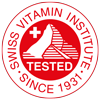
Vitamins, nutrition & health
A vitamin is a substance that is essential in small amount to the nutrition and health of most animals and humans; it does not provide energy or serve as building block for the body, and it is present in food or sometimes produced within the body such as vitamin D upon sun exposure and vitamin K produced by probiotic gut bacteria.
Vitamin A
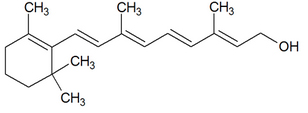
Vitamin A is a fat-soluble vitamin that comes from two sources: retinoids and provitamin carotenoids. Vitamin A is fundamental for the structure and efficiency of skin, eye and mucosa. Deficiency of vitamin A may cause blindness, skin problem and is a serious problem in emerging countries for children healthy development. Hypervitaminosis of vitamin A may cause nausea and vomiting, and neurological disorder.
Below, recommended daily dose (according to Swiss Nutrition Society).
Found in
| Vitamin A retinol | Provitamin A carotenoids |
| Veal liver | Spirulina |
| Beef Liver | Carrots |
| Cod liver oil | Peppers |
| Halibut liver oil | Mangoes |
| Butter / Margarine | Spinach |
| Egg | Sweet potatoes |
| Cheese | Tomato |
| Tuna | Apricot |
| Whole milk | Squash |
A part of β-carotene is converted in vitamin A retinol
Daily dose for women
| Vitamin A Retinol | |
| Age | mg/day |
| 13-14 years | 1.0 |
| 15-18 years | 0.9 |
| Adult | 0.8 |
| Provitamin A Carotenoids | |
| 2 to 4 mg/day. |
Daily dose for men
| Vitamin A Retinol | |
| Age | mg/day |
| 13-14 years | 1.1 |
| 15-18 years | 1.1 |
| Adult | 1 |
| Provitamin A Carotenoids | |
| 2 to 4 mg/day. |
Vitamin B1
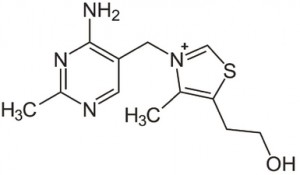
Vitamin B1 Thiamin is a soluble molecule that was one of the first to be recognized as vitamin. It ensures the normal fonction of nervous system and muscles. Deficiency in vitamin B1 causes Beriberi and associated symptoms such as tiredness, muscular weakness disorder of memory and concentration, lassitude and anorexia. Alcoholism decreases absorption of vitamin B1. Very little thiamin is stored in the body, depletion can occur within 14 days and hypervitaminosis is rare.
Below, recommended daily dose according to Swiss Nutrition Society.
Found in
| Yeast |
| Pork |
| Cured Ham |
| Oatmeal |
| Wheat whole grain |
| Asparagus |
| Peas |
| Sunflower seed |
| Oranges |
Daily dose for women
| Age | mg/day |
| 13-14 years | 1.1 |
| 15-24 years | 1.0 |
| 25-50 years | 1.0 |
| 51-64 years | 1.0 |
| +65 years | 1.0 |
Daily dose for men
| Age | mg/day |
| 13-14 years | 1.4 |
| 15-24 years | 1.3 |
| 25-50 years | 1.2 |
| 51-64 years | 1.1 |
| +65 years | 1.0 |
Vitamin B2
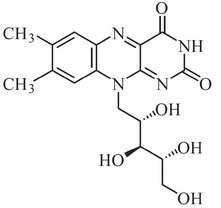
Vitamine B2 Riboflavin participates in the recovery of energy from foods. Vitamin B2 contributes to skin, red blood cell and nervous system functions. Deficit in vitamin B2 can be caused by alcohol consumption or poor diet. Toxicty of vitamin B2 is very low and hypervitaminosis of it is not expected.
Below, recommended daily dose according to Swiss Nutrition Society.
Found in
| Beef |
| Pork |
| Almond |
| Bean |
| Broccoli |
| Paris Mushroom |
| Wheat whole |
| Soya |
Daily dose for women
| Age | mg/day |
| 13-14 years | 1.3 |
| 15-24 years | 1.2 |
| 25-50 years | 1.2 |
| 51-64 years | 1.2 |
| +65 years | 1.2 |
Daily dose for men
| Age | mg/day |
| 13-14 years | 1.6 |
| 15-24 years | 1.5 |
| 25-50 years | 1.4 |
| 51-64 years | 1.3 |
| +65 years | 1.2 |
Vitamin B5

Pantothenic acid is important for the metabolisms of fatty acids, amino acids and carbohydrates. Promotes growth and resistance of skin and mucous membranes. Used in cosmetic for acne, against hair loss, and their elasticity. Deficiency in vitamin B5 is very rare. Hypervitaminosis of vitamin B5 is negligible.
Below, recommended daily dose (according to Swiss Nutrition Society).
Found in
| Yeast |
| Liver Pork |
| Chicken Liver |
| Egg |
| Peanuts |
| Wheat bran |
| Mushroom |
| Lentils |
| Avocado |
Daily dose for women
6 mg/day
Daily dose for men
6 mg/day
Vitamin B6
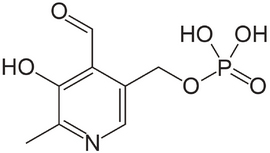
Vitamin B6 participates in the metabolisms of glycogen, lipids, amino acids and in the synthesis of hemoglobine. Vitamin B6 is very important for transport of iron. Deficit may cause skin problem and hair loss, insomnia, weakness and nervous disorder. Hypervitaminosis of vitamin B6 can cause sensory nerve damage and skin lesion, symptoms that are similar to vitamin B6 deficiency.
Below, recommended daily dose (according to Swiss Nutrition Society).
Found in
| Garlic |
| Green beans |
| Pepper |
| Banana |
| Whole rice |
| Potatoes |
| Chickpea |
| Beef |
| Pork |
Daily dose for women
| Age | mg/day |
| 13-14 years | 1.4 |
| 15-48 years | 1.2 |
| 19-64 years | 1.2 |
| Plus 65 years | 1.2 |
Daily dose for men
| Age | mg/day |
| 13-14 years | 1.4 |
| 15-18 years | 1.6 |
| 19-64 years | 1.5 |
| Plus 65 years | 1.4 |
Vitamin B12
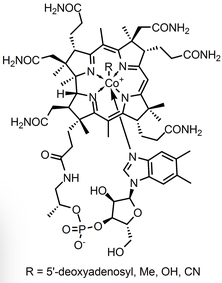
Vitamin B12 is water-soluble vitamin. Vitamin B12 is important in DNA synthesis. B12 is released from the food by acid in the stomach and binds to the so called intrinsic factor before it is absorbed into the bloodstream. Absence of the intrinsic factor due to loss of parietal cells in the stomach (autoimmune disease, Helicobacter pylori infection) leads to failure to absorb vitamin B12 and can cause a type of anemia called pernicious anemia. The body stores several years’ worth of vitamin B12 in the liver, so low levels in the body are rare but more common in the elderly, vegetarians and vegans. Hypervitaminosis of vitamin B12 is an under-estimated phenomenom arising to disease (cancer and other) and excessive B12 supplementation.
Below, recommended daily dose according to Swiss Nutrition Society.
Found in
|
Beef liver |
|
Beef |
|
Chicken |
|
Clams |
|
Oysters |
|
Trout |
|
Cheese |
|
Egg |
Daily dose for women
3.0 µg/day
Daily dose for men
3.0 µg/day
Vitamin C
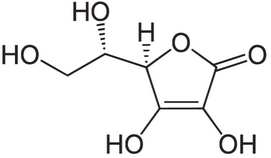
Vitamin C (acid ascorbic) is an antioxidant. Vitamin C contributes to production of collagen that is necessary to the structure and function of skin, bones, blood vessels and many other tissues. Vitamin C increases the absorption of iron from plant origin. Vitamin C can be regenerated by vitamin E. Deficiency is usually due to a poor diet or a greater need in vitamin C by an individual. Deficit in vitamin C causes scurvy. Symptoms of scurvy are tiredness, bleeding gums and tooth loss, muscle aches, skin lesion and appearance of many bruising. There is no hypervitaminosis of vitamin C, however, too much of vitamin C can cause kidney disease.
Below, recommended daily dose according to Swiss Nutrition Society. But smoker, top athlete, diabetic, person with chronic illness or infection need more than the recommended dose.
Found in
|
Blackcurrant |
|
Guavas |
|
Strawberries |
|
Oranges |
|
Kiwi |
Daily dose for women
100 mg/day
Daily dose for men
100 mg/day
Vitamin D
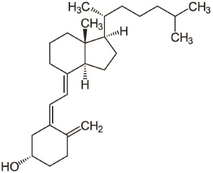
The term “vitamin D” includes different forms of this vitamin. Vitamin D2 is made by plants, and vitamin D3 by human skin from cholesterol upon sunlight exposure. Vitamin D is fat-soluble and critical to calcium absorption as well as to the regulation of phosphorous and calcium metabolisms. It is important for bone mineralisation and the function of the immune system. Sunlight exposure is the principal source of vitamin D in the organism. Deficiency of vitamin D may cause bone softness, osteomalacia and rickets. Deficiency arises from inappropriate diet, low sun exposure, poor body metabolism, and certain drugs. Hypervitaminosis of vitamin D may cause hypercalciuria, loss of appetite, nausea and vomiting and dehydration.
Below, recommended daily dose according to Swiss Nutrition Society.
Found in
|
Cod liver oil/Cod |
|
Sardines |
|
Salmon |
|
Fera fish |
|
Mushrooms |
|
Lamb meat |
|
Egg |
|
Cheese |
|
Butter/Margarine |
Daily dose for women
| Age | µg/day |
| Minus 65 years | 15 |
| Plus 65 years | 20 |
Daily dose for men
| Age | µg/day |
| Minus 65 years | 15 |
| Plus 65 years | 20 |
Vitamin E

Different forms of vitamin E exist (alpha-, beta-, gamma-, and delta-tocopherol; and alpha-, beta-, gamma-, and delta-tocotrienol).
Vitamin E is a fat-soluble and has antioxidant properties. Vitamin E can be regenerated by vitamin C. Premature children are exposed to a deficit in vitamin E. Deficit in vitamin E is the result of malabsorption due disease and rarely of poor diet. Hypervitaminosis of vitamin E can reduce other fat-soluble vitamins (A, D, K) in the body and lead in particular to bleeding problems due to vitamin K deficiency.
Below, recommended daily dose (according to Swiss Nutrition Society).
Found in
| Vegetal oil (wheat germ, sunflower olive…) |
| Almond |
| Hazelnut |
| Maize |
| Oats |
| Soybean |
| Barley |
| Blackberry |
| Avocado |
Daily dose for women
| Age | mg/day |
| 13-14 years | 12 |
| 15-24 years | 12 |
| 25-50 years | 12 |
| 51-64 years | 12 |
| Plus 65 years | 11 |
Daily dose for men
| Age | mg/day |
| 13-14 years | 14 |
| 15-24 years | 15 |
| 25-50 years | 14 |
| 51-64 years | 13 |
| Plus 65 years | 12 |
Vitamin K
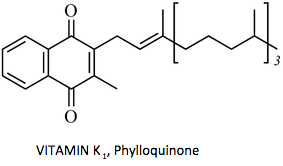
Vitamin K is a group of fat-soluble vitamins produced by plants (K1) and bacteria (K2). Vitamin K is important for blood coagulation and the metabolism of bones ans tissues. Deficiency in vitamin K is rare in adults and is caused by drugs (anticoagulants, antibiotics) and malabsorption due disease. The result is a coagulation problem, hemorrhages and anemia.
Newborn have risk of low level in vitamin K. Only hypervitaminosis of the synthetic vitamin K (K3) was reported to have serious adverse effects.
Below, recommended daily dose (according to Swiss Nutrition Society).
Found in
| Kale |
| Spinach |
| Soy Beans |
| Broccoli |
| Cauliflower |
| Egg Yolk |
Daily dose for women
| Age | µg/day |
| 13-14 years | 50 |
| 15-50 years | 60 |
| Plus 51 years | 65 |
Daily dose for men
| Age | µg/day |
| 13-14 years | 50 |
| 15-50 years | 70 |
| Plus 51 years | 80 |
Vitamin PP
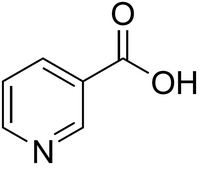
Niacin participates in the recovery of energy from food, and proper function of the nervous system, skin and mucosa. Deficiency in vitamin PP can cause fatigue, nausea and vomiting, insomnia, depression and finally pellagra (sun sensitivity and dementia). Alcoholism can cause deficiency. Toxicity of vitamin PP is low but hypervitaminosis may cause headache, itching, liver damage, diarrhea and depression.
Below, recommended daily dose (according to Swiss Nutrition Society).
Found in
| Wheat |
| Green beans |
| Peas |
| Whole rice |
| Chicken |
| Beef |
| Tuna |
| Mushroom |
| Lentils |
Daily dose for women
| Age | mg/day |
| 13-14 years | 15 |
| 15-24 years | 13 |
| 25-50 years | 13 |
| 51-64 years | 13 |
| Plus 65 years | 13 |
Daily dose for men
| Age | mg/day |
| 13-14 years | 18 |
| 15-24 years | 17 |
| 25-50 years | 16 |
| 51-64 years | 15 |
| Plus 65 years | 13 |
Vitamin Biotin
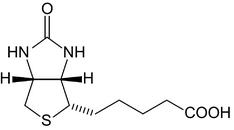
Biotin is essential to fatty acids and amino acids metabolisms.
Recommended for strengthening hair and nails and skin function. Biotin deficiency is rare as it is synthesized by the intestinal microflora. Inborn genetic disorders and dysbiosis of the gastrointestinal tract (inflammatory bowel, obesity, or colitis affecting the balance of the microflora) are the main causes of biotin deficiency. Defiency can cause skin inflammation (dermatitis), hair loss (alopecia), conjunctivitis or neurological symptoms. There are no reported hypervitaminosis of vitamin biotin.
Below, recommended daily dose (according to Swiss Nutrition Society).
Found in
| Yeast |
| Wheat Bran |
| Peanuts |
| Walnuts |
| Oats |
| Sorghum |
| Soybeans |
| Cauliflower |
| Egg |
Daily dose for women
| Age | µg/day |
| 13-14 years | 25-35 |
| Plus 15 years | 30-60 |
Daily dose for men
| Age | µg/day |
| 13-14 years | 25-35 |
| Plus 15 years | 30-60 |
Vitamin Folic Acid
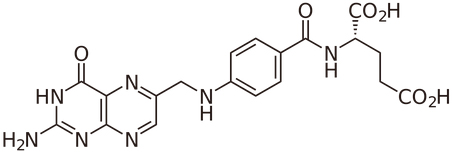
Together with vitamin B12 folic acid ensures the proper function of red blood cells, and normal cell division. Folic acid participates in the metabolisms of amino acids and nucleotides. It is required for the normal development of the neural tube. Folic acid supplementation during pregnancy decreases the occurrence of a birth defect called Spina bifida, due to the neural tube defect during the development where there is incomplete closing of the spinal cord. Deficiency may cause megaloblastic anaemia and skin lesion. Hypervitaminosis of folic acid is rare and can mask a B12 vitamin deficiency.
Below, recommended daily dose (according to Swiss Nutrition Society).
Found in
| Yeast |
| Beef |
| Dry white beans |
| Chickpea |
| Peanut |
| Brussels sprouts |
| Spinach |
| Margarine |
| Egg |
Daily dose for women
400 µg/day
Daily dose for men
400 µg/day
